Introduction
Objective
The objective of the report is to demonstrate the occurrence of alternation of generation in a fern plant. Specifically, it entails the haploid generation, which is the development of spores through meiosis, and the diploid generation, which is the development and maturation of sporophytes through mitosis.
Background
Fern is a unique plant that exhibits alternation of generation in its reproductive cycle. The alternation of generation means the existence of both sporophyte and gametophyte generations in the productive cycle of the fern. Sporophyte generation is a diploid generation that undergoes meiosis and leads to the formation of spores. The formed spores comprise a haploid generation that undergoes mitosis, which leads to the formation of gametes. The fusion of the male and female gametes results in the formation and development of a sporophyte, which shifts to the diploid generation and the devolvement of spores. The sporophyte generation is not only a dominant generation but also visible, while the gametophyte generation is a tiny generation that grows independent of the sporophyte. Therefore, the experiment demonstrated the occurrence of the alteration of generation in a fern plant.
Results
Life Cycles
Diploid-haploid cycle
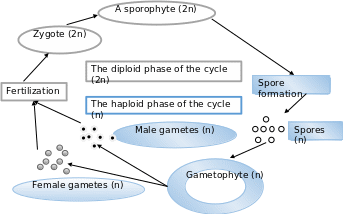
Unicellular-multicellular Cycle
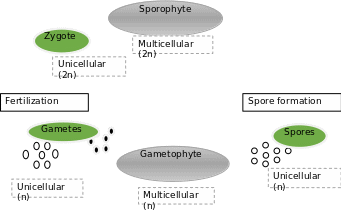
Mitosis-Meiosis Cycle
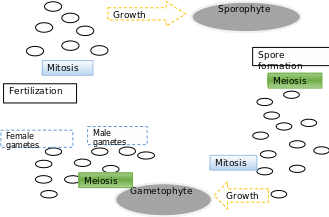
Description of Observations
First Period (Day 0)
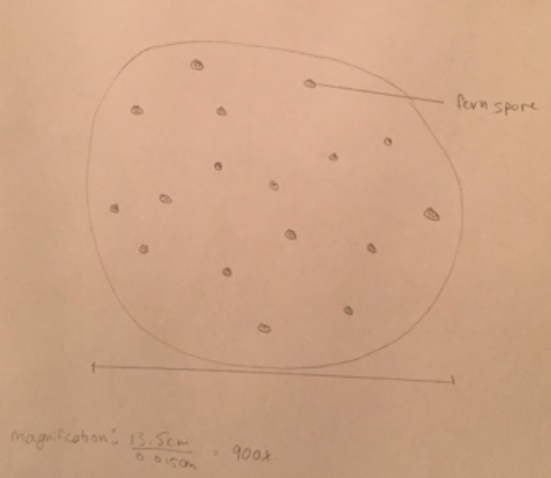
The observation of the fern spores under the microscope revealed their shape and conformation. Visibly, fern spores appear oval and rough when observed under the microscope when magnified 900 times. Figure 1 depicts the shape and texture of the fern spores. In the life cycle, these spores are the products of the meiosis, have haploid chromosomes (n), and are unicellular.
Second Period (Day 4-7)
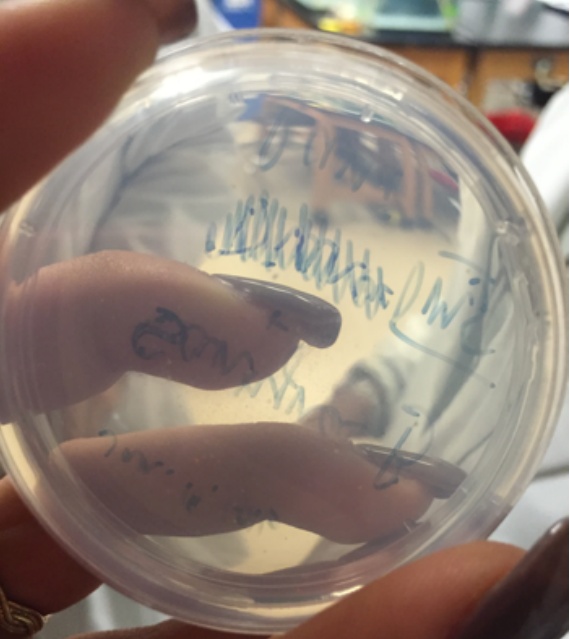
The observations of the spores spread on the media on the fourth to seventh day indicate spores being the same as the first period. However, some spores appeared larger than the previous spores, which means that they have absorbed water and started germinating. Moreover, some spores appeared green and larger than the first spores; hence, indicating that they had germinated. In the life cycle, the spores are in the mitotic phase, which is the division and growth of cells into a multicellular gametophyte.
Third Period (Day 8-14)
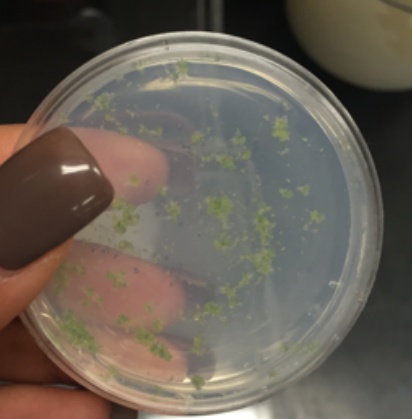
The observation of the Petri dishes shows that the spores have germinated and grown. The germination of the spores is evident as there are green patches on the media, as shown in Figure 3. In the life cycle, the growth of the fern is at the gametophyte phase, where the gametophytes grow and mature.
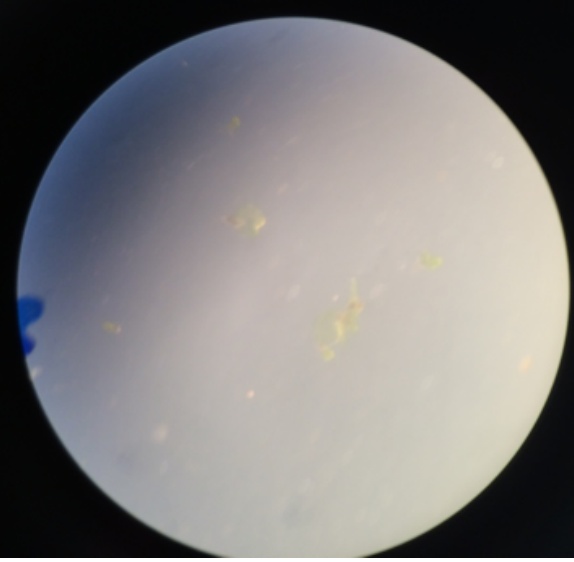
The examination under the microscope shows green and white patches, which reflect different parts of the growing gametophyte (Figure 4). The structure of the green structures depicts that the stage of development is the mitotic growth of the gametophyte.
Fourth Period (Day 14-21)
At this period, gametophytes have matured because there have leafy and root-like structures. The leafy structures are prothallia, while the root-like structures are rhizoids. At this stage of the life cycle, the gametophyte undergoes meiosis leading to the formation of gametes, and eventually, fertilization takes place. The formation of gametes occurs through the process of meiosis, where multicellular gametophyte (n) produces unicellular gametes (n).
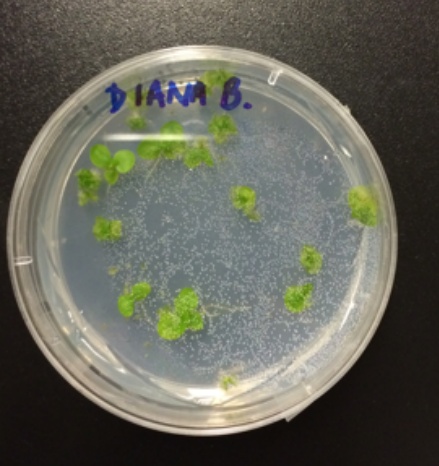
Observation of the gametophyte under the microscope shows prothallia. A prothallium is a body of the gametophyte that comprises archegonium and antheridium, which are female and male reproductive organs, respectively. The archegonia and antheridia appear as thick and green structures that are on the prothallia, as shown in Figure 6. Hence, the structure of the growing fern indicates that it is at the gametophyte stage, where meiosis causes the formation of the gametes, fertilization, and the growth of the sporophyte.
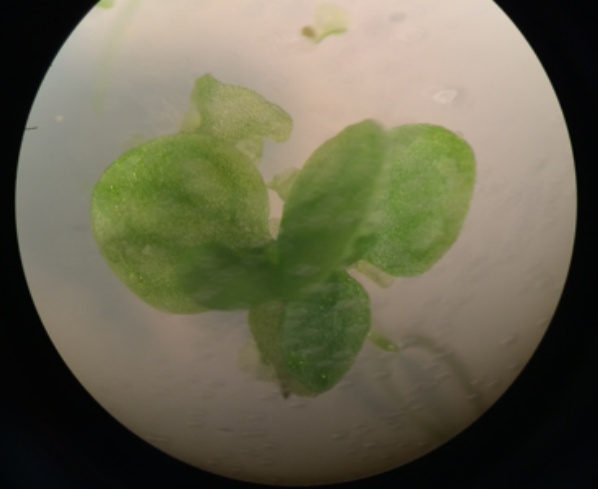
Discussion
A comparison of the life cycle of C-fern and fungi shows that they have some differences and similarities. The similarity between C-fern and fungi is the existence of the alternation of haploid and diploid generations. Both c-fern and fungiform spores and zygote in their life cycles. However, the difference is that c-fern has gametes while fungi do not have games. In the fern, male and female gametes fuse to form a zygote, whereas, in fungi, nuclei fuse to form a zygote. At the same time, the gametes of the fern fuse in the process called fertilization resulting in the formation of a zygote, nuclei of fungi fuse in the process called karyogamy, resulting in the formation of a zygote (Muthukumar & Prabha, 2012). Another difference is that the fern has gametophytes while fungi have no gametophyte. Fungi also have an asexual reproduction cycle, while the fern only has sexual reproduction.
C-fern and gymnosperm are plants that exhibit alternation of the generation. The similarity between the c-fern and gymnosperm is the production of spores through meiosis, the formation of gametophytes, and fertilization to form a zygote. However, the difference is that the gametophyte of the fern is independent of the sporophyte, while the gametophyte of the gymnosperm is dependent on the sporophyte. However, sporophyte forms the major generation while the gametophyte forms the minor generation, the fern and gymnosperm exhibit different gametophytes. The gametophyte of the c-fern forms gametes that fertilize each other, while gymnosperm has sporophyte forms microspores and megaspores to form a zygote.
Angiosperms and c-fern are similar as they exhibit alternation of generation in their reproductive cycle. Both plants have spores and zygotes in their life cycles. However, the difference is that the gametophyte generation of independent in the fern while it is dependent on angiosperm. Moreover, another difference is that angiosperms have double fertilization while c-fern have single-fertilization. Megaspore and microspore fertilize to form a zygote in angiosperms, while the gametes fertilize to form a zygote in the fern.
The evolutionary advantage of the alternation of a generation that the fern exhibits is that it enhances the survival of plants in different environments. For instance, the sporophyte generation is the main plant that grows in the terrestrial environment for a long period, while gametophyte is the minor generation that grows in the terrestrial environment for a short period (Niklas & Kutschera, 2010). Moreover, the existence of spores is an adaptive strategy that allows ferns to survive in unfavorable conditions for a long period before they germinate into a gametophyte. Niklas and Kutschera (2010) explain that multicellularity is an evolutionarily adaptive strategy that enables plants to conserve water and protect themselves from ultra-violet radiations. Moreover, the existence of haploid and diploid stages in the life cycle helps in the preservation of genes.
References
Muthukumar, T., & Prabha, K. (2012). Fungal associations in gametophytes and young sporophytic roots of the fern Nephrolepis exaltata. Acta Botanica Croatica, 71(1), 139-146.
Niklas, K., & Kutschera, U. (2010). The evolution of the land plant life cycle. New Phytologist, 184(1), 27-41.